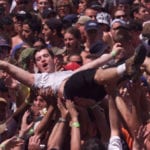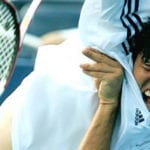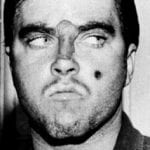 Music
Music  Music
Music  History
History 10 Less Than Jolly Events That Occurred on December 25
 Weird Stuff
Weird Stuff 10 Funny Ways That Researchers Overthink Christmas
 Politics
Politics 10 Political Scandals That Sent Crowds Into the Streets
 Weird Stuff
Weird Stuff Ten Bizarre Facts About The Doge Meme
 Our World
Our World 10 Ways Your Christmas Tree Is More Lit Than You Think
 Movies and TV
Movies and TV The 10 Coolest Stars to Set Sail on The Love Boat
 History
History 10 Things You Didn’t Know About the American National Anthem
 Technology
Technology Top 10 Everyday Tech Buzzwords That Hide a Darker Past
 Humans
Humans 10 Everyday Human Behaviors That Are Actually Survival Instincts
 Music
Music 10 Surprising Origin Stories of Your Favorite Holiday Songs
 History
History 10 Less Than Jolly Events That Occurred on December 25
 Weird Stuff
Weird Stuff 10 Funny Ways That Researchers Overthink Christmas
Who's Behind Listverse?

Jamie Frater
Head Editor
Jamie founded Listverse due to an insatiable desire to share fascinating, obscure, and bizarre facts. He has been a guest speaker on numerous national radio and television stations and is a five time published author.
More About Us Politics
Politics 10 Political Scandals That Sent Crowds Into the Streets
 Weird Stuff
Weird Stuff Ten Bizarre Facts About The Doge Meme
 Our World
Our World 10 Ways Your Christmas Tree Is More Lit Than You Think
 Movies and TV
Movies and TV The 10 Coolest Stars to Set Sail on The Love Boat
 History
History 10 Things You Didn’t Know About the American National Anthem
 Technology
Technology Top 10 Everyday Tech Buzzwords That Hide a Darker Past
 Humans
Humans 10 Everyday Human Behaviors That Are Actually Survival Instincts
10 Sporting Events That Ended in Tragic Deaths of Athletes
If you watched the Tokyo Summer Olympics, you were reminded of how jaw-dropping these Olympians’ feats of skill, strength, and endurance can be. But sometimes, it’s good to be reminded that athletes often risk not just failure but their life. Here are 10 instances when athletes lost far more than a trophy.
Related: Top 10 Forgotten Murders Of Once-Famous Athletes
10 An Entire Soccer Team Killed on the Field
It’s quite common for participants in sporting events to pray or appeal to a deity for help in a game. Apparently, in the central African nation of Congo, they may also utilize witchcraft. In late October 1998, the village of Bena Tshadi was hosting a soccer (football) match against the nearby village of Basangana in the south-central Congolese province of Eastern Kasai. The game was tied 1-1 when lightning struck the field (pitch), killing all 11 members of the Bena Tshadi team and injuring more than 30 spectators standing on the sidelines. It is the only known instance of an entire team dying on a playing field.
Investigators determined that the freak lightning bolt was the result of witchcraft, no doubt conjured by someone rooting for the Basangana team. That team, after all, walked off the field without a single injury. According to the Congolese Press Agency, sorcery is commonly used to influence games. Not to trample on their beliefs, but lightning strikes to open soccer fields are not at all rare. That same weekend, six soccer players were injured when lightning interrupted their game in South Africa.[1]
9 The 90-Mile-An-Hour Death of Nodar Kumaritashvili
In the years before the 2010 Winter Olympics in Vancouver, the International Olympic Committee had drawn criticism for its efforts to elevate interest in the games by adding more dramatic, more dangerous events such as snowboarding and ski cross. It also used technology and track designs to push existing events such as the luge to faster and faster speeds. Josef Fendt, president of the International Luge Foundation, was one of those concerned about Vancouver’s Whistler Sliding Center track where luge, skeleton, and bobsled teams would compete. After record speeds and some accidents by seasoned luge athletes during an international training week at Whistler, Fendt felt the track was just too fast.
Worse, many Olympic athletes complained that they did not have adequate time to practice—not just on Whistler, but also on the ski courses and the speed skating oval. In the week before the Vancouver Olympics, athletes trained on Whistler, and many of them crashed, among them the two-time defending gold medal luger Armin Zoeggeler of Italy.
One luger who hoped to dethrone Zoeggeler was Nodar Kumaritashvili from the Republic of Georgia. Nodar had been competing on the luge since he was 14, seven years before, and according to his father, had never sustained an injury. But Nodar was worried about Whistler, and his father, an experienced luger himself from the Soviet era, told him to start his run farther down the course to slow his speed. Nodar was shocked at the suggestion, replying that he came to the Olympics “to win,” adding, “I will either win or die.”
On February 10—two days before the opening ceremonies—Nodar rolled down Whistler on his back, feet-first, for his second practice run. He crashed. Undeterred, he continued practicing, and on the Friday morning of the ceremonies, he launched his fifth practice run. The run went well, and by the time Nodar reached curve 16, the final turn on the track, he was traveling just under 90 mph. Nicknamed Thunderbird, turn 16 was a sweeping right curve.
As Nodar approached the banked end of Thunderbird, his luge slid downward, his left hand and feet attempting to slow his progress. He hit a wall, upending his luge and sending Nodar over the track’s lip and into two vertical supports, sustaining massive head and torso injuries. He was pronounced dead at the hospital. Olympic organizers blamed the accident on Nodar’s inexperience and claimed it had nothing to do with “deficiencies in the track.” They said the subsequent changes to the track—they altered the Thunderbird turn, moved the starting line further down the track, and wrapped padding around the supports—were simply to soothe the athlete’s fears.[2]
8 Sweet Kiss of Death
Among the more shocking horse races in the last century was the June 4, 1923, race at New York’s Belmont Park when a longshot named Sweet Kiss and its jockey, Frank Hayes, won. Part of the surprise was that Sweet Kiss was not a winning horse. Records are sketchy, but it appears the horse had won for its owner, a Ms. A.M. Frayling, a paltry sum of $1,775 ($28,000 in 2021 money) in its career and was given 20-1 odds to win the Belmont race. Hayes, too, was a longshot as he worked the stables, was not a jockey, and had never raced a horse before. The reason Hayes was tapped to jockey Sweet Kiss is unknown, but it was reported that he had to drop from 142 pounds to 130 pounds in just one day to take the saddle. On the morning of the race, Hayes spent hours jogging while denying himself food and water just to reach his target weight.
There is a surviving photo of Sweet Kiss and Hayes during the race, and sometime after the photo was taken, but before crossing the finish line, Hayes died of a massive heart attack. As Frayling and officials rushed up to the winners, Hayes tumbled out of the saddle, already dead. Hayes has the dubious distinction of never losing a race and being the only known jockey to win a race as a corpse. Sweet Kiss never raced again as jockeys refused to ride it. Legend has it the horse was given the nickname of Sweet Kiss of Death.[3]
7 A First No One Would Want
It shouldn’t be surprising that boxing ranks among the top 10 most dangerous sports. Some 90% of all boxers receive some brain damage during their careers, and about 10 fighters a year die of injuries sustained in the ring.
Between 1884, when the Queensberry Rules were adopted, and 1995, an estimated 500 boxers died from their injuries. Twenty-two died in 1953 alone. Perhaps the most famous incident was when Jimmy Doyle died of brain injuries after a punch from Sugar Ray Robinson in a 1947 world welterweight title fight. Just last April, 18-year-old Rashed Al-Swaisat of Jordan died after a knockout blow during the world youth championships.
In 1993, USA Boxing lifted the ban on women in the ring, opening the door for, among others, Laila Amaria Ali (Muhammed Ali’s daughter), Mia St. John, and disgraced figure skater Tonya Harding to compete. Among the 2,200 women registered by USA Boxing in 2005 was Becky Zerlentes, who had a Ph.D. in geography, a black belt in Goshin Jitsu, a brown belt in taekwondo, and competed in triathlons, synchronized swimming, and kickboxing while teaching economics and swimming at a community college. Oh, and she became the Colorado Golden Gloves champ in 2002.
On April 2, 2005, Zerlentes stepped into the ring against Heather Schmitz for a Golden Gloves championship bout. Zerlentes vowed it was her last bout since USA Boxing barred anyone over 34—her age at the time—to fight. Both women passed pre-fight physicals and donned regulation headgear. In the 2nd round, Schmitz socked Zerlentes in the face, causing her nose to bleed. After her nose bleed was staunched, the bout continued, and in the 3rd round, Schmitz delivered a blow to Zerlentes’ left temple, sending her to the mat. She never regained consciousness, dying the next afternoon.
The autopsy determined that the blow to Zerlentes head jarred her brain, causing it to bleed uncontrollably. The coroner found no vascular malformation or aneurysm that might have ruptured with the blow. Nor did Zerlentes have any drugs in her system. It was just an unfortunate blow—one Zerlentes had shrugged off numerous times—that opened up a blood vessel. She was the first woman to die from an injury at a sanctioned amateur boxing event.[4]
6 Death by Celebration
A perusal of the risks of death in sporting events reveals few surprises. For instance, boxing has about 46 deaths for every 100,000 participants. BASE jumping has about 43 deaths, while skydiving has one fatality in 100,000 jumpers. Around 1,000 drivers die for every 100,000 who race behind a steering wheel, while 100 racers die astride a motorbike. Swimming—which includes open water and endurance swimming—has two fatalities per 100,000 participants, while scuba diving has three.
One surprise, however, is the number of deaths during or immediately after soccer games. One study found that there may be as many as seven deaths out of every 100,000 footballers due to cardiac arrest alone. And this does not count fatalities due to collisions with other players, the ground, and the ball, resulting in head injuries, ruptured bowels, ruptured kidneys, ruptured blood vessels, and even infections due to broken bones. Nor does it count the unusual deaths due to lightning strikes (see #10), due to disappointed fans, or being shot by police (stay tuned).
The October 2014 death of Peter Biaksangzuala definitely falls in the latter category. Peter, a 23-year-old midfielder for Bethlehem Vengthlang FC, India, was in the 62nd minute of a match against Chanmari West when he scored the game-tying point. He then celebrated with a somersault, one he misjudged. He landed awkwardly on his neck and collapsed on the field. He was rushed to the hospital, where a CT scan determined he had extensive damage to his spinal cord. He lingered for five days before succumbing.[5]
5 Death by Snow Groomer
The year 1992 marked the last time the winter and summer Olympics were held in the same year, and the Albertville (France) Winter Olympics were the first after the fall of the Soviet Union. Six former Soviet-bloc countries formed a Unified Team while the Baltic states of Estonia, Lithuania, and Latvia and a newly reunified Germany participated in the Olympics as independent nations for the first time since 1936.
On the next-to-last day of the Olympics, Swiss speed skier Nicolas Bochatay, 27, was warming up for the finals on a public slope at La Lechere, France. Bochatay used slalom skis instead of his wider speed skis as he and teammate Pierre Yves-Jorand roared down the slope at top speed. As Bochatay approached a hill, people downslope started shouting and waving off the skiers. Too late, Bochatay flew over the hill only to find a snow groomer—a vehicle that works the snowpack for optimal skiing—on the other side. He slammed into the groomer, sustaining massive internal injuries and dying immediately. The Swiss team claimed the snow groomer was idle, hidden behind the hill without its siren or flashing lights activated. Other witnesses disagreed.[6]
4 Bloody Sunday (1920)
The citizens of Dublin, Ireland, awoke on the morning of November 21, 1920, to gunfire. The Irish War of Independence had been raging for nearly two years between British forces and the Irish Republican Army (IRA). That Sunday morning, the IRA touched off coordinated assassinations of undercover British intelligence agents, killing 15 and wounding five. In pursuit of the assailants, the police arrived at Croke Park, where a soccer match between the Tipperary and Dublin soccer teams was being held. The police suspected some of the assassins had slipped in among the soccer fans. At 3:25 that afternoon—10 minutes into the game—the police blocked the Croke Park exits, and a contingent was sent in to search the crowds—estimated to be 5,000 strong—for IRA gunman.
Who fired the first shot is still, a century later, under dispute, but the police began firing indiscriminately into the crowds. The first shot was 11-year-old William Robinson, who had climbed a nearby tree to better view the game. Shot in the chest, William died later at the hospital. Two other schoolboys—Jerome O’Leary, 10, and John William Scott, 14—were also killed, along with Jane Boyle, a shopkeeper who was to be married in only five days. A military inquiry later concluded the police shootings were excessive and unauthorized.
At least three members of the IRA were also killed at Croke Park, one of them a footballer on the Tipperary team. Michael Hogan was team captain as well as captain of the Grangemockler company of the IRA. In the melee, Hogan was shot in the back at the corner of the pitch, now known as Hill 16. Tom Ryan, a gas fitter, was one of the IRA volunteers sent to kill a British agent that morning (the target was not at home). He decided to attend the Tipperary vs. Dublin game that afternoon. He was reportedly whispering the rites of contrition in Michael Hogan’s ear when he himself was shot in the stomach and died later.[7]
3 “The Honor of My Race, Family and Self Are at Stake”
The October 6, 1923, game between the Iowa State Cyclones and the University of Minnesota Gophers meant a lot to 21-year-old Jack Trice. He was the only African-American on the football field, and this was his first game for the Cyclone’s varsity team. While most African Americans were only allowed to attend black colleges in the South, they had been attending Iowa for 32 years by then. But none had ever played on a Cyclone varsity team, and Jack, a sophomore, was on two varsity teams: football and track.
Jack felt the weight of his responsibility the night before the game. Using a piece of hotel stationery, Jack wrote down his feelings and intentions for the next day: “My thoughts just before the first real college game of my life. The honor of my race, family, and self is at stake.” As the Cyclone’s defensive lineman, Jack said he would “break thru the opponents’ line and stop the play in their territory.” Last, he told himself to “watch for crossbucks and reverse end runs” and “roll block” any runners.
American football in the early decades of the 20th century was brutal. Helmets were leather and had no padding or facemask. Padding under the uniform was minimal, mostly along the shoulders. Many plays that are illegal now—such as the roll block—were perfectly legal back in 1923.
In the first half of the game, Jack broke his collarbone but refused to leave the field. At halftime, the game was tied 7-7, but by the middle of the third quarter, Minnesota had pulled ahead 14-7 and had the ball. At the snap, the Gophers sent a gaggle of blockers to clear the way for their fullback. Jack ran right at them, throwing himself in front of the blockers and rolling forward to trip them. It was a roll block, but instead of rolling on his belly, Jack rolled onto his back. “The fullback, going through the hole, stepped on Jack’s stomach and maybe his groin,” recalled a teammate. “He was badly hurt but tried to get up and wanted to stay in. We saw he couldn’t stand and helped him off the field.” He was taken to a local hospital where doctors determined Jack could travel back to Iowa with his dejected team. They had lost the game 20-17. Jack died two days later of internal bleeding.
Questions still persist about whether Jack was purposely or accidentally stepped on. We’ll probably never know. Iowa, however, refused to play Minnesota for the next 66 years. In the 1980s, a statue was erected of Jack that stands outside Jack Trice Stadium, the only major college stadium named after an African American.[8]
2 The Final Ride of Lane Frost
Bull riding is another extremely dangerous sport, with 20 catastrophic injuries for every 100,000 riders. Between 1989 and 2016, at least 21 professional bull riders died, along with an unknown number of amateurs. For instance, in 2016, a 15-year-old amateur was trampled to death by a bull after being thrown at a New Mexico rodeo. It happened again in 2019 at the Denver Western Stock Show when a pro bull rider was thrown, and the bull brought its 2,000 pounds down on the rider’s chest, killing him.
Lane Frost was born into a rodeo family, his father a bronco buster and calf roper. And while his parents tried to steer Lane away from the dangerous bull riding sport, Lane’s attention seemed riveted to it. According to his Mom, Elsie, his first spoken word was “bull,” and he’d go around the house riding a toy horse on rollers, claiming he was riding one.
At five, Lane often sat astride the arm of a couch, pretending it was a bucking bull. He graduated to riding calves on the family’s Utah dairy farm, and when the family moved to Oklahoma, he came under the tutelage of legendary bull rider Freckles Brown. At 19, Lane was a member of the Professional Rodeo Cowboys Association and became a favorite on the circuit. He was crowned the world champion at 23 and went to the Calgary Olympics in 1988 to compete in a rodeo exhibition.
The Cheyenne (Wyoming) Frontier Days was the largest and oldest rodeo in the world, and on the last day (July 30) of the 1989 event, Lane was set to ride a tough but not particularly mean bull that some sources called Takin’ Care of Business (TCB). Lane’s ride of TCB was perfect, lasting the proscribed 8 seconds, and as TCB turned right, Lane dismounted to the left, landing safely on his hands and knees. Then TCB did something unexpected: he turned and drove his right horn into Lane’s back. “A lot of bulls do that. It’s kinda their nature,” said another bull rider Cody Lambert. “It’s something that happens to every one who rides bulls, and sometimes you get a nick or a bruise. But usually you just get up, and later everyone pats you on the back and laughs about it. That’s what it looked like. I’ve seen a lot worse wrecks [gores] than Lane had there.” But TCB’s horn had broken some of Lane’s ribs and punctured a major artery. Lane got up, took a few steps, then signaled for help before falling into the mud. Within minutes he was dead. Lane was inducted into the ProRodeo Hall of Fame the next year. Five years after his death, Lane was immortalized in the movie 8 Seconds.[9]
1 Death by Fans
Every sport has fans who lose their minds and toss anything and everything at the athletes. Basketball had the 2004 infamous “Malice in the Palace” when a fan threw a cup of beer at Indiana Pacer Ron Artest. Baseball has the lemons thrown by Chicago Cubs fans at New York Yankee Babe Ruth during the third game of the 1932 World Series. Legend has it, the lemons prompted the Babe to “call his shot,” pointing at center field before swatting a home run in that direction. For golf, there’s the fan who threw a hot dog at Tiger Woods in 2011 (how much anger management therapy should you receive if you’ve lost it at a golf game?). But these incidents reach a whole new level when the projectiles become deadly.
On August 23, 2014, Albert Ebosse Bodjongo, 24, was playing for the Algerian soccer club JS Kabylie at home against another Algerian team—USM Alger. Albert scored the only point for his team in their loss, 2-1. As the home team ran off the field, they were pelted by objects from the fans that allegedly included roof tiles from a nearby construction site. A short time later, Albert was dead from a blow to the head that was sufficient to crack his skull and push pieces of it into his brain. Initially, it was determined that Albert had been hit by a heavy, sharp object thrown by the fans. The truth was far more sinister.
His family was not satisfied with the official cause of death and hired a pathologist to conduct another autopsy which found the head injury was delivered at close range, not from the fans in the stands. Worse, Albert had a stab wound near a collarbone as well as wounds consistent with an assault. Had fans attacked and murdered Albert in the locker room? His murderer has still not been identified.
If this seems far-fetched, soccer fans have a history of violence. Peruvian fans were incensed during a May 24, 1964, game between Peru and Argentina when a referee disallowed a game-tying point to count with just two minutes remaining. One fan ran onto the pitch to smack the referee, and dozens followed, creating a riot. The police launched tear gas into the crowds, creating panic and starting a stampede toward the locked steel gates. As many as 328 were crushed to death. About 127 fans died in a similar riot during a 2001 game in Ghana.
Seventy-three died at Port Said, Egypt, during a soccer brawl in 2012. Then there’s Andres Escobar, who contributed to Columbia’s loss to the U.S. when he accidentally deflected the ball into his own goal in the 1994 World Cup. A little more than a week later, Escobar was confronted at a hometown restaurant and shot multiple times, the killer reportedly shouting “Goal” as he fired.[10]








